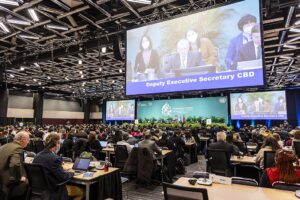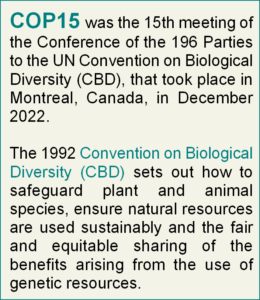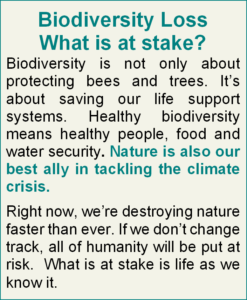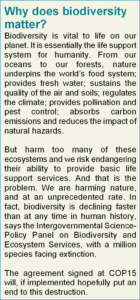
This is the second article to mark Laudato Si Week 2023, which this year has the theme of “Hope for the Earth, Hope for Humanity. Our ability to promote and protect Biodiversity is a not only a great source of hope for the earth – but also for humanity which is part of and not separate from Biodiversity.
 Background: The 15th Meeting of the Conference of Parties to the UN Convention on Biological Diversity, known as COP15, was originally scheduled for 2020 and set to take place in Kunming, China. But Covid-19 intervened resulting in its postponement and the transferring of the Conference to Canada in 2022. The targets agreed at previous Biodiversity Conferences have not been met, largely due to a lack of funding and political will. Therefore, at COP15 there was pressure to put in place the financial and political support needed to achieve progress.
Background: The 15th Meeting of the Conference of Parties to the UN Convention on Biological Diversity, known as COP15, was originally scheduled for 2020 and set to take place in Kunming, China. But Covid-19 intervened resulting in its postponement and the transferring of the Conference to Canada in 2022. The targets agreed at previous Biodiversity Conferences have not been met, largely due to a lack of funding and political will. Therefore, at COP15 there was pressure to put in place the financial and political support needed to achieve progress.
COP15 closed, with the adoption of the Kunming-Montreal Global Biodiversity Framework. 196 nations agreed long-term goals and action-oriented targets to be delivered by 2030 and 2050. This agreement has been hailed as nature’s Paris Agreement and commits nations to actions to protect and restore nature and remove pollution. (See: https://environment.ec.europa.eu/topics/nature-and-biodiversity/eu-cop15-global-biodiversity-conference_en)

Outcomes: The Kunming-Montreal biodiversity agreement includes key global targets to:
- Restore 30% of degraded ecosystems globally (on land and sea) by 2030. Currently only 17 percent and 10 percent of the world’s terrestrial and marine areas respectively are under protection.
- Conserve and manage 30% of terrestrial and marine areas by 2030
- Stop the extinction of known species, and reduce tenfold the extinction risk and rate of all species by 2050.
- Reduce risk from pesticides by at least 50% by 2030.
- Reduce pollution risks and negative impacts of pollution from all sources by 2030 to levels that are not harmful to biodiversity and ecosystems.
- Sustainably manage areas under agriculture, aquaculture, fisheries, and forestry and substantially increase agroecology and other biodiversity-friendly practices.
- Tackle climate change through nature-based solutions.
- Secure the safe, legal and sustainable use and trade of wild species by 2030.
- Increase benefit sharing from the use of genetic resources to support biodiversity conservation and its sustainable use.
- The deal will also significantly increase finance for biodiversity from all sources (domestic, international – both public and private) mobilising at least $200 billion (USD) per year by 2030. It also addresses subsidies harmful to biodiversity.
- The Framework requires governments to ensure that large and transnational companies disclose their risks, dependencies and impacts on biodiversity.
 The Framework agreed at the end of COP15 is an ambitious final agreement. It triples the commitments to conservation made at COP10 in Japan in 2010 and is the largest commitment to ocean and land conservation in history. It has also clearly identified many other needed and action-oriented targets that the parties have agreed to deliver by 2030 or 2050.
The Framework agreed at the end of COP15 is an ambitious final agreement. It triples the commitments to conservation made at COP10 in Japan in 2010 and is the largest commitment to ocean and land conservation in history. It has also clearly identified many other needed and action-oriented targets that the parties have agreed to deliver by 2030 or 2050.
But: The Framework is not legally binding and there has been criticism of its failure to establish quantifiable targets, timelines for monitoring actions and for its “weak” and future-oriented language. In short COP15, while making significant progress in terms of gaining political backing, identifying both a pathway to progress and the financial resources needed to support it, is still a voluntary agreement. It is short on concrete steps that nail down exactly the when, how and who of implementing its recommendations.
Next steps: Before COP16 in 2024, all countries party to the agreement are required to prepare updated National Biodiversity Strategies and Action Plans and National Biodiversity Finance Strategies. In parallel to policy action, countries and multilateral financial institutions are also expected to work to mobilise financing.
There is a long way to go, and the history of the meetings of the COP to the UN Convention on Biological Diversity is marked with failures of implementation. At the end of COP15 Virginijus Sinkevičius, the EU Commissioner for the Environment, Oceans and Fisheries said:
“Today’s deal is an all-round win and I am proud we made it. The real work starts now to turn the words on paper into real action around the world.”
The effectiveness of future meetings of the Biodiversity COP in leading to real actions required to protect biodiversity remains to be seen. Therefore, future COP meetings will need to assess if the cumulative impact of national actions is sufficient to reach the global goals and targets for 2030 and 2050. In addition, no time should be lost in establishing and agreeing firm time-linked steps and mechanisms that will guide the implementation of the Framework agreed in 2022.

